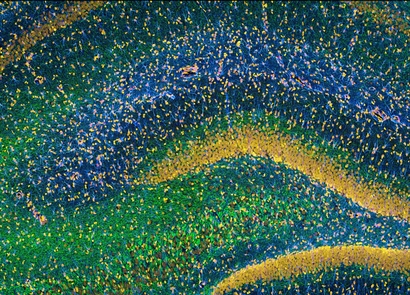Sunday, November 28, 2010
Motivate your workers with appreciation
Perhaps it seems elementary, but Don says if you want employees who are fully engaged, you need to ensure they are recognized when they do great work and that they know you appreciate their contributions to the organization.
Don is so convinced of the importance of his findings that he takes his own advice to a high level.
"One of the ways I let our employees know how much they are appreciated is through my Thanksgiving routine," he says. "It is by far my favorite day of the year to work. I get to the office by 8 a.m. and start calling each employee.
"During those calls I let them know how thankful I am that they choose to spend their days at Modern Survey. I mention at least one special contribution they have made to the company over the previous few months. I let them know how much I am looking forward to doing great things with them in the months and hopefully years ahead. I want them to know I am so grateful they are a part of our team that I am willing to work my holidays for them. It makes for an exciting and emotional morning, and I always feel fulfilled once I have made my last call."
Then Don goes a step further.
"After I am finished calling each employee, I call clients, my closest friends, and my immediate family members," he said. "I thank the clients (mostly on voicemail) for their support and loyalty. My friends and family are thanked for being a part of my life and for helping make me who I am."
I wonder if Don makes it home in time for Thanksgiving dinner! For the record, Modern Survey has 23 employees, making his session relatively manageable. But it's the creativity and the personal touch that intrigue me.
Employee recognition is a fundamental concept in successful companies. Thanksgiving is a very appropriate time of year to express your gratitude for loyalty, hard work and a positive attitude. Holidays present a terrific opportunity to thank employees - but they certainly aren't the only time of year to let your staff know what their efforts mean to the company.
Recognition consultants Adrian Gostick and Chester Elton, authors of "The 24-Carrot Manager" and "A Carrot a Day," say recognition is most effective when it is:
- Positive. Managers should not use recognition events as "a time to talk about how far someone has come, or how they could have done even better." Keep comments positive.
- Immediate. "The closer the recognition to the actual performance the better."
- Close. "Recognition is best presented in the employee's work environment among peers."
- Specific. "Point out specific behaviors that reinforce key values."
- Shared. "Recognition that means the most often comes from peers who best understand the circumstances surrounding the employee's performance. Peers, as well as managers and supervisors, should be able to comment during the presentation."
Don't assume employees know how much you appreciate their efforts just because they still have a paycheck. Never waste an opportunity to say thank you.
Mackay's Moral: You may not spend your Thanksgiving like Don MacPherson, but really, is Thanksgiving limited to only one day a year?
by Harvey Mackay - Nov. 21, 2010 06:34 PM
Motivate your workers with appreciation
Saturday, November 27, 2010
Get LILLIAN WONG on the Go...There's an App for that!

Sunday, November 21, 2010
The Really Strange Story Behind Sunday's Blue Moon - Yahoo! News

The full moon of November arrives on Sunday and will bring with it a cosmic addition: It will also be a so-called "blue moon."
"But wait a minute," you might ask. "Isn't a 'blue moon' defined as the second full moon that occurs during a calendar month? Sunday's full moon falls on Nov. 21 and it will be the only full moon in November 2010. So how can it be a 'blue' moon?"
Indeed, November's full moon is blue moon – but only if we follow a rule that's now somewhat obscure.
In fact, the current "two- full moons in one month" rule has superseded an older rule that would allow us to call Sunday's moon "blue." To be clear, the moon does not actually appear a blue color during a blue moon, it has to do with lunar mechanics.
Confused yet?
Well, as the late Paul Harvey used to say — here now, is the rest of the story:
The blue moon rule
Back in the July 1943 issue of Sky & Telescope magazine, in a question and answer column written by Lawrence J. Lafleur, there was a reference made to the term "blue moon." [Gallery - Full Moon Fever]
Lafleur cited the unusual term from a copy of the 1937 edition of the now-defunct Maine Farmers' Almanac (NOT to be confused with The Farmers' Almanac of Lewiston, Maine, which is still in business).
On the almanac page for August 1937, the calendrical meaning for the term "blue moon" was given.
That explanation said that the moon "... usually comes full twelve times in a year, three times for each season."
Occasionally, however, there will come a year when there are 13 full moons during a year, not the usual 12. The almanac explanation continued:
"This was considered a very unfortunate circumstance, especially by the monks who had charge of the calendar of thirteen months for that year, and it upset the regular arrangement of church festivals. For this reason thirteen came to be considered an unlucky number."
And with that extra full moon, it also meant that one of the four seasons would contain four full moons instead of the usual three.
"There are seven Blue Moons in a Lunar Cycle of nineteen years," continued the almanac, ending on the comment that, "In olden times the almanac makers had much difficulty calculating the occurrence of the Blue Moon and this uncertainty gave rise to the expression 'Once in a Blue Moon.'"
An unfortunate oversight
But while LaFleur quoted the almanac's account, he made one very important omission: He never specified the date for this particular blue moon.
As it turned out, in 1937, it occurred on Aug. 21. That was the third full moon in the summer of 1937, a summer season that would see a total of four full moons.
Names were assigned to each moon in a season: For example, the first moon of summer was called the early summer moon, the second was the midsummer moon, and the last was called the late summer moon.
But when a particular season has four moons, the third was apparently called a blue moon so that the fourth and final one can continue to be called the late moon.
So where did we get the "two full moons in a month rule" that is so popular today?
A moon mistake
Once again, we must turn to the pages of Sky & Telescope.
This time, on page 3 of the March 1946 issue, James Hugh Pruett wrote an article, "Once in a Blue Moon," in which he made a reference to the term "blue moon" and referenced LaFleur's article from 1943.
But because Pruett had no specific full moon date for 1937 to fall back on, his interpretation of the ruling given by the Maine Farmers' Almanac was highly subjective. Pruett ultimately came to this conclusion:
"Seven times in 19 years there were – and still are – 13 full moons in a year. This gives 11 months with one full moon each and one with two. This second in a month, so I interpret it, was called Blue Moon."
How unfortunate that Pruett did not have a copy of that 1937 almanac at hand, or else he would have almost certainly noticed that his "two full moons in a single month assumption" would have been totally wrong.
For the blue moon date of Aug. 21 was most definitely not the second full moon that month!
Blue moon myth runs wild
Pruett's 1946 explanation was, of course, the wrong interpretation and it might have been completely forgotten were it not for Deborah Byrd who used it on her popular National Public Radio program, "StarDate" on Jan. 31, 1980.
We could almost say that in the aftermath of her radio show, the incorrect blue moon rule "went viral" — or at least the '80s equivalent of it.
Over the next decade, this new blue moon definition started appearing in diverse places, such as the World Almanac for Kids and the board game Trivial Pursuit.
I must confess here, that even I was involved in helping to perpetuate the new version of the blue moon phenomenon. Nearly 30 years ago, in the Dec. 1, 1982 edition of The New York Times, I made reference to it in that newspaper's "New York Day by Day" column.
And by 1988, the new definition started receiving international press coverage.
Today, Pruett's misinterpreted "two full moons in a month rule" is recognized worldwide. Indeed, Sky & Telescope turned a literary lemon into lemonade, proclaiming later that – however unintentional – it changed pop culture and the English language in unexpected ways.
Meanwhile, the original Maine Farmers' Almanac rule had been all but forgotten.
Playing by the (old) rules
Now, let's come back to this Sunday's full moon.
Under the old Almanac rule, this would technically be a blue moon. In the autumn season of 2010, there are four full moons:
- Sept. 23
- Oct. 22
- Nov. 21
- Dec. 21
"But wait," you might say. "Dec. 21 is the first day of winter."
And you would be correct, but only if you live north of the equator in the Northern Hemisphere. South of the equator it's the first day of summer.
In 2010, the solstice comes at 6:38 p.m. EST (2338 UT).
But the moon turns full at 3:13 a.m. EST (0813 UT). That's 15 hours and 25 minutes before the solstice occurs. So the Dec. 21 full moon occurs during the waning hours of fall and qualifies as the fourth full moon of the season.
This means that under the original Maine Almanac rule – the one promoted by Lafleur and later misinterpreted by Pruett – the third full moon of the 2010 fall season on Nov. 21 would be a blue moon.
Choose your blue moon
So what Blue Moon definition tickles your fancy? Is it the second full moon in a calendar month, or (as is the case on Sunday) the third full moon in a season with four?
Maybe it's both. The final decision is solely up to you.
Sunday's full moon will look no different than any other full moon. But the moon can change color in certain conditions.
After forest fires or volcanic eruptions, the moon can appear to take on a bluish or even lavender hue. Soot and ash particles, deposited high in the Earth's atmosphere, can sometimes make the moon appear bluish.
In the aftermath of the massive eruption of Mount Pinatubo in the Philippines in June 1991, there were reports of blue moons (and even blue suns) worldwide.
We could even call the next full moon (on Dec. 21) a "red moon," but for a different reason: On that day there will be a total eclipse of the moon and, for a short while, the moon will actually glow with a ruddy reddish hue.
More on that special event in the days to come here at SPACE.com, so stay tuned!
by Joe Rao Space.com November 19, 2010
Scientists recommend one-way trips to Mars

PULLMAN, Wash. - It's always cheaper to fly one way, even to Mars.
Two scientists are suggesting that colonization of the Red Planet could happen faster and more economically if astronauts behaved like the first settlers to come to North America - not expecting to go home.
"The main point is to get Mars exploration moving," said Dirk Schulze-Makuch, a Washington State University professor who co-authored an article that seriously proposes what sounds like a preposterous idea.
At least one moon-walking astronaut was not impressed.
"This is premature," Ed Mitchell of Apollo 14 wrote in an e-mail. "We aren't ready for this yet."
Also cool to the idea was NASA. President Barack Obama has already outlined a plan to go to Mars by the mid-2030s. But he never suggested these space travelers wouldn't come home.
"We want our people back," NASA spokesman Michael Braukus said.
The article titled "To Boldly Go" appears in the latest issue of the Journal of Cosmology, which featured more than 50 articles and essays on Mars exploration.
Schulze-Makuch and Paul Davies, a physicist at Arizona State University, argue that humans must begin colonizing another planet as a hedge against a catastrophe on Earth. They believe the one-way trips could start in two decades.
"You would send a little bit older folks, around 60 or something like that," Schulze-Makuch said, bringing to mind the aging heroes who saved the day in the movie "Space Cowboys."
That's because the mission would undoubtedly reduce a person's lifespan, from a lack of medical care and exposure to radiation. Radiation could also damage reproductive organs, so sending people of childbearing age is not a good idea, Schulze-Makuch said.
Mars is a six-month flight away, possesses surface gravity, an atmosphere, abundant water, carbon dioxide and essential minerals. The two scientists propose the missions begin with two two-person teams, in separate ships that would serve as living quarters on the planet. More colonists and regular supply ships would follow.
The technology already exists, or is within easy reach, they wrote. By not taking the extra fuel and provisions necessary for a return trip to Earth, the mission could cut costs by 80 percent.
Davies and Schulze-Makuch say it's important to realize they're not proposing a "suicide mission."
"The astronauts would go to Mars with the intention of staying for the rest of their lives, as trailblazers of a permanent human Mars colony," they wrote.
They acknowledge the proposal is a tough sell for NASA, with its focus on safety, and suggest the private sector might be more fertile ground.
"What we would need is an eccentric billionaire," Schulze-Makuch said. "There are people who have the money to put this into reality."
Indeed, British tycoon Richard Branson, PayPal founder Elon Musk and Amazon.com Inc. CEO Jeff Bezos are among the rich who are already involved in private space ventures.
Isolated humans in space have long been a staple of science-fiction movies, from "Robinson Crusoe on Mars" and "2001: A Space Odyssey" to a flurry of recent movies such as "Solaris" and "Moon." In many of the plots, lonely astronauts fall victim to computers, madness or aliens.
Psychological profiling and training of the astronauts, plus constant communication with Earth, would reduce debilitating mental strains, the two scientists said.
"They would in fact feel more connected to home than the early Antarctic explorers," they write in their article.
The mental health of humans in space has been extensively studied. Depression can set in, people become irritated with each other, and sleep can be disrupted, studies have found. The knowledge that there is no quick return to Earth would likely make that worse.
Both men contend that Mars has abundant resources to help the colonists become self-sufficient over time. They write that the colony should be next to a large ice cave, to provide shelter from radiation, plus water and oxygen.
Schulze-Makuch and Davies believe a Mars base would offer humanity a "lifeboat" if Earth became uninhabitable.
by Nicholas K. Geranios Associated Press Nov. 21, 2010 12:00 AM
Scientists recommend one-way trips to Mars
Saturday, November 20, 2010
Arizona voters have approved medical marijuana measure
The secretary of state's unofficial results indicate that the "yes" vote on the Arizona Medical Marijuana Act has won by a narrow margin of 4,341 votes, or 50.13 percent of more than 1.67 million votes counted.
This is after Maricopa County officials finished counting about 11,000 outstanding ballots Saturday.
The "yes" and "no" votes remained neck and neck for more than a week since Election Night, with the "yes" vote trailing by at least 3,000 each day. But the "yes" vote picked up traction after elections officials started counting provisional ballots, and by Friday, it was leading by 4,421 for the first time.
Arizona will be the 15th state to legalize medical marijuana.
The general-election canvass will be held Nov. 29. The Arizona Department of Health Services has 120 days from that day to finalize all rules for implementation. The department is expected to begin reviewing dispensary and patient applications by April 2011.
Andrew Myers, campaign manager for the pro-Prop. 203 Arizona Medical Marijuana Policy Project, said he believes there are more Arizonans who support medical marijuana than what the votes show. He said voter skepticism was rooted in concerns that Arizona's medical-marijuana program would be similar to ones in California and Colorado.
But Myers said Prop. 203 was written to create a strict and regulated medical-marijuana program.
"It's up to us now to prove them wrong and assuage those concerns," Myers said.
The state health department and local planning and zoning officials have said they would implement as many rules as possible to ensure the program is tightly regulated, and for the benefit of patients with debilitating diseases.
But Carolyn Short, chairwoman of the anti-Prop. 203 campaign Keep AZ Drug Free, said Friday that voters will find they voted for a "concept," and anybody who wants marijuana will get it. Short said Saturday that she is disappointed to see Prop. 203 pass.
Chris Ross, administrator and owner of Arizona's Medical Marijuana Community, an online forum where users can share information on doctors, dispensaries and marijuana strains, said there still will be a stigma around patients using marijuana for a while. He created the website so that patients can discreetly access information and find which doctors are sympathetic to the use of marijuana as a medicine, he said.
Ross, whose sister has stage four breast cancer, said he is "ecstatic" Prop. 203 pulled through.
"It was disappointing (at first), but when the tide turned on Friday, I was just in shock," Ross said. "The people who oppose it see the worst-case scenario, but I see the best-case scenario. People like my sister - they're going to get the help they need."
Supporters of the measure attribute the vote surge to provisional ballots, which voters cast when there is a question about the voter's eligibility. Provisional voters tend to be younger people whose addresses do not match the voter roll because they move around often, Myers said.
The U.S. Food and Drug Administration has not approved smoking marijuana for medical uses.
Licensed physicians could recommend medical marijuana to patients with debilitating medical conditions, including cancer, glaucoma, HIV/AIDS, hepatitis C and Alzheimer's disease. Patients would register for identification cards with the state health department. They could also receive up to 2 1/2 ounces of marijuana every two weeks from dispensaries or cultivate up to 12 plants if they live 25 miles or more from a dispensary.
The law allows for no more than 124 dispensaries operated by non-profits to start, proportionate to the number of pharmacies in the state.
by Michelle Ye Hee Lee The Arizona Republic Nov. 13, 2010 06:43 PM
Arizona voters have approved medical marijuana measure
Thursday, November 18, 2010
Eye-Popping Microscope Images

1st Place: Daddy longlegs
1st Place 2010 Olympus BioScapes Digital Imaging Competition: Eyes of daddy longlegs. A frontal section of Phalangium opilio eyes. The lenses, retinas and optic nerves are visible. The image is a depth color-coded projection of a confocal image stack.« Read less
(Igor Siwanowicz, Max Planck Institute for Neurobiology, Munich, Germany)
2nd Place: Rat hippocampus
2nd Place 2010 Olympus BioScapes Digital Imaging Competition: Rat hippocampus. Widefield multiphoton fluorescence image stained to reveal the distribution of glia, neurofilaments and cell nuclei.« Read less
(Thomas Deerinck, National Center for Microscopy and Imaging Research)
3rd Place: Solitary coral
3rd Place 2010 Olympus BioScapes Digital Imaging Competition: Solitary coral. The tentacle tips, called acrospheres, are visibly enhanced using a technique… Read more »
(James Nicholson, Coral Culture & Collaborative Research Facility)4th Place: Living Licmophora juegensii
4th Place 2010 Olympus BioScapes Digital Imaging Competition: Living Licmophora juegensii on red alga, together with the diatom Cocconeis and filamentous… Read more »
(Wolfgang Bettighofer, Kiel, Germany)5th Place: Weedy flower
5th Place 2010 Olympus BioScapes Digital Imaging Competition: Dadpour Primordium of the weedy flower at its final stages of development. More than 100 z-stacks… Read more »
(M. Reza Dadpour, University of Tabriz, Iran)6th Place: Gubernator Spirogyra
6th Place 2010 Olympus BioScapes Digital Imaging Competition: Gubernator Spirogyra. Brightfield and polarized light.
(Jerzy Gubernator, Faculty of Biotechnology, University of Wroclaw)7th Place: Blue damselfly eye
7th Place 2010 Olympus BioScapes Digital Imaging Competition: Siwanowicz eye of a commmon blue damselfly. This projection of a series of confocal microscope… Read more »
(Igor Siwanowicz, Max Planck Institute for Neurobiology)8th Place: Beetle leg
8th Place 2010 Olympus BioScapes Digital Imaging Competition: Beetle leg. Lateral view of the adhesive pad of the first leg of a beetle captured using… Read more »
(Jan Michels, Christian Albrecht University of Kiel, Germany)
9th Place: Wildflower seeds
9th Place 2010 Olympus BioScapes Digital Imaging Competition: Wildflower seeds. Image captured using brightfield reflected light.
(Yanping Wang, Beijing, China)10th Place: Weevil head
10th Place 2010 Olympus BioScapes Digital Imaging Competition: Weevil. Image was captured using episcopic illumination.
(Laurie Knight, Tonbridge, Kent, UK)Scientists claim breakthrough in antimatter hunt - Yahoo! News
An international team of physicists at the European Organization for Nuclear Research, or CERN, managed to create an atom of anti-hydrogen and then hold onto it for long enough to demonstrate that it can be studied in the lab.
"For us it's a big breakthrough because it means we can take the next step, which is to try to compare matter and antimatter," the team's spokesman, American scientist Jeffrey Hangst, told The Associated Press.
"This field is 20 years old and has been making incremental progress toward exactly this all along the way," he added. "We really think that this was the most difficult step."
For decades, researchers have puzzled over why antimatter seems to have disappeared from the universe.
Theory posits that matter and antimatter were created in equal amounts at the moment of the Big Bang, which spawned the universe some 13.7 billion years ago. But while matter — defined as having mass and taking up space — went on to become the building block of everything that exists, antimatter has all but disappeared except in the lab.
Hangst and his colleagues, who included scientists from Britain, Brazil, Canada, Israel and the United States, trapped 38 anti-hydrogen for about one tenth of a second, according to a paper submitted to the respected science journal Nature.
Since their first success, the team has managed to hold the anti-atoms even longer.
"Unfortunately I can't tell you how long, because we haven't published the number yet," Hangst told the AP. "But I can tell you that it's much, much longer than a tenth of a second. Within human comprehension on a real clock."
Scientists have long been able to create individual particles of antimatter such as anti-protons, anti-neutrons and positrons — the opposite of electrons. Since 2002, they have also managed to lump these particles together to form anti-atoms, but until recently none could be trapped for long enough to study them, because atoms made of antimatter and matter annihilate each other in a burst of energy upon contact.
"It doesn't help if they disappear immediately upon their creation," said Hangst. "So the big goal has been to hold onto them."
Two teams had been competing for that goal at CERN, the world's largest physics lab best known for its $10 billion smasher, the Large Hadron Collider. The collider, built deep under the Swiss-French border, wasn't used for this experiment.
Hangst's ALPHA team got there first, beating the rival ATRAP team led by Harvard physicist Gerald Gabrielse, who nevertheless welcomed the result.
"The atoms that were trapped were not yet trapped very long and in a very usable number, but one has to crawl before you sprint," he told the AP.
Many new techniques painstakingly developed over five years of experimental trial and error preceded the successful capture of anti-hydrogen.
To trap the anti-atoms inside an electromagnetic field and to stop them from annihilating atoms, researchers had to create anti-hydrogen at temperatures less than half a degree above absolute zero.
"Think of it as a marble rolling back and forth in a bowl," said Hangst. "If the marble is rolling too fast (i.e. the anti-atom is too hot) it just goes over the edge."
Next, scientists plan to conduct basic experiments on the anti-atom, such as shining a laser onto it and seeing how it behaves, he said.
"We have a chance to make a really precise comparison between a matter system and an antimatter system," he said, "That's unique, that's never been done. That's where we're headed now."
Hangst downplayed speculation that antimatter might someday be harnessed as a source of energy, or to create a powerful weapon, an idea popularized in Dan Brown's best-selling novel "Angels and Demons."
"It would take longer than the age of the universe to make one gram of antimatter," he said, calling the process "a losing proposition because it takes much more energy to make antimatter than you get out of it."
Sunday, November 14, 2010
Six amazing things city dwellers miss out on - Yahoo! News
Life in the big city is never lacking for good food, things to do, new art, or scores of people to meet. The hustle and bustle, edgy attitudes, and blissful anonymity do the trick for many an urbanite.
But sometimes, the cramped apartments and hustle and bustle leave city folk wishing for more frequent journeys toward open skies and expanses of green.
The following are six amazing things city dwellers miss out on.

(Photo: Stellarium.org)
Stars
Inner-city night skies often look like an empty, hazy void, because light pollution easily drowns out the universe's twinkling mass of stars, planets, and meteorites. Throw in the reflective effects of air pollution, and urban star-gazing can be almost impossible, leaving many city dwellers oblivious to the cosmic kaleidoscope overhead. For star chasers who venture beyond this blinding glow, however, the sky is no longer the limit. On clear nights, rural and some suburban skies reveal a dazzling display of star power, much like what our ancestors saw before the rise of artificial lighting.Try visiting some truly unlit "dark-sky sites" for the best views — such as Mauna Kea in Hawaii, the Great Basin Desert in Nevada, or the Adirondack Public Observatory in New York — but don't completely ignore the heavens back home.
Even big cities may have darker areas that allow for decent views on moonless nights, and if all else fails, you can always just turn your telescope on the moon itself. Let's see light pollution block that.

(Photo: jesse.millan / Flickr)
Fresh air
Most of us prefer the smell of fresh-cut grass to the belch of diesel fumes. But experts say dense urban environments really do have higher levels of air pollution than their less populated, suburban counterparts.On the American Lung Association’s most polluted list in 2010: Cities like Los Angeles and Phoenix, where researchers found high levels of ozone (smog) and particle (soot) pollution. As for the locales with the cleanest air? Try Bismark, ND, and Cheyenne, WY.
Not surprisingly, Los Angeles received an "F" grade from researchers measuring pollution levels and associated risks, like asthma and other chronic lung ailments. But towns like Duluth, MN, scored an easy "A," no doubt letting residents breathe a little easier.

(Photo: moonjazz / Flickr)
Peace and quiet
New Yorkers boast of a city that never sleeps, but one of the coolest places on earth can also be one of the noisiest. The average noise level in Times Square is a whopping 80 decibels. For comparison’s sake, a whisper is measured at 20 decibels and normal conversation is around 65.Other cities are equally noisy: Las Vegas’ Strip averages 68 decibels and San Francisco’s Union Square is 65. A quiet suburb is far quieter (50) and rural areas, by comparison, are practically silent (30) — unless there’s a vacuum cleaner running, which can ratchet noise levels back to 70 decibels. But even that doesn’t compare to the city subways, with a noise level of 102 decibels.
After a while, that noise takes a toll, leading to hearing loss, stress and hypertension.

(Photo: Laura Padgett / Flickr)
Greenery
In the world’s biggest cities, tall skyscrapers sprout more frequently than fresh tree saplings — but that doesn’t mean urban dwellers don’t know what they are missing.Seattle, a city that values its trees, recently fined a judge $500,000 for cutting down 120 cherry and maple trees. Urban jungles like New York and Los Angeles have launched ambitious campaigns to plant 1 million trees.
It’s no wonder that city dwellers have their eye on the emerald prize, as a number of studies show that greenery boosts our health. Just five minutes of exercise a day in an outdoor setting can improve your mental state.
Healthy children and leafy suburbs also go together, according to asthma researchers. In a New York City-based study, asthma rates among children fell by a quarter for every 340 trees per square kilometer.
In all, the U.S. Forest Service maintains 193 million acres of national forest and grassland nationwide — meaning ours is a pretty green country.

(Photo: tlindenbaum / Flickr)
Sounds of nature
During the summer months, suburbanites often hear these singing insects before they see them. With their spirited acoustics, cicadas are hard to miss.The inch-long bug's distinctive buzzing, humming, and clicking are produced by males at astounding volumes. (Some of the loudest cicada songs reach 120 decibels, which translates to a pretty loud mating, courting, or distress call.)
Seemingly pervasive in some climates, a cicada's adult live is brief. Juveniles, or nymphs, live underground most of their lives and emerge for two to six weeks in the heat of the summer.
But they don’t tread lightly. Tens of thousands have been known to blanket an acre of land in Kentucky, Tennessee, and West Virginia. Though there are thousands of species, the most common species emerge every 13 or 17 years. So if you missed the great cicada concerts of 2004, get ready for 2011.

(Photo: mararie / Flickr)
Animals and wildlife
Cities certainly aren't devoid of wildlife -- from pigeons and crows to opossums and coyotes, plenty of animals eke out a living on the streets.But while many species have adapted well to city life, they rarely match the size, numbers, or diversity of animals in natural habitats. Old-growth ecosystems teem with flora and fauna, and they have a lot to offer people who can read their signs.
Early humans used animals' clues to help them find prey, for example. Even if hunting isn't on the agenda, modern-day nature lovers can still use the same tactics to track wildlife, whether for photography or just for fun.
Look for animal tracks in soft ground like mud or snow, but check how fresh they are -- dead plants in the tracks probably means they're old. Look for signs of feeding, too, like stripped bark or scattered berries, and don't be afraid to study a little dung. The size of droppings can tell you how big an animal is, what it eats, and how close it is.
Other nature-savvy tricks can have even more practical uses, like Native Americans' various ways of predicting winter -- bears' hibernation spots were said to reveal how cold it would be, while the width and furriness of snowshoe hares' feet helped with snowfall forecasts. Ancient Europeans similarly looked to furry rodents for wintry hints, later bringing the practice to America, where it evolved into Groundhog Day.
And animals can even tip off natural disasters, such as pressure-sensing fish that dive deeper to avoid hurricanes or Italian toads that flee earthquakes days in advance.
by E.B. Solomont Mother Nature Network – November 11, 2010
Six amazing things city dwellers miss out on - Yahoo! News
Paid to put in client's 2 cents
"Do you actually get paid to write that (expletive)?"
And that's just from family and friends.
I'm kidding. Sort of. Other readers wonder:
"Are you seriously willing to attach your name and photograph to that (expletive)?"
I get the same type of comments from readers who add their opinions to columns and blogs that appear on azcentral .com, the newspaper's Internet site.
Almost always the queries are made anonymously.
Those of us in the news business are accustomed to readers posting at the end of articles or columns.
Anonymous jeers are to news writers what hecklers are to comedians.
I didn't know until recently, however, that some of those anonymous readers actually are being paid to post responses.
I was on the phone with a young man who told me that a friend of his had what he called a "side job" filing anonymous posts on Internet sites that ranged from news operations to mainstream business websites and more.
He said that even a casual search of the Internet would turn up dozens of operations offering money for blog posts.
And it's true. There are such businesses. And it's been going on for years. (The fact that I just heard about this may indicate that the readers wondering why I get paid may have a point.)
Back in 2006, for instance, Bloomberg Businessweek published an article titled "Polluting the blogosphere" that described the practice. The story reads in part: "Advertisers pay to post details about their 'opportunity,' specifying, among other things, how they want bloggers to write about, say, a new shoe, if they want photos to be included, and whether they'll pay only for positive mentions. Bloggers who abide by the rules get paid; heavily trafficked blogs may command premium rates."
There seems to be no law requiring an anonymous poster on an Internet website to announce whether he or she is being paid.
Some of the companies who advertise for such bloggers are very open about the arrangement. One that I looked at said that after a blogger signs on with the company, an "administrator then assigns writing tasks for what our advertisers want you to mention in your blog."
A friend of mine who once worked in newspapers and now represents politicians and political campaigns says that mainstream websites like azcentral.com are littered with paid blog posts.
They're like the audience "volunteer" in a magic act who actually is a plant by the magician. Only multiplied by . . . hundreds? Thousands?
The young man who told me about this said that his friend earns roughly 5 cents per post. He said that his friend uses as many as 10 different fake identities when posting and earns enough money on a good week for "beer money."
Not exactly a career path, but quick easy cash.
News writers know that staff members working for politicians and business interests will post anonymously on a website to make their causes or their bosses look good.
This is different. There's something creepy about getting paid 5 cents to put in a client's 2 cents worth. Although there is a positive side - at least for me.
For the first time in 20 years, I figure that I now get to respond to every expletive-laced rhetorical comment I receive by asking:
"Do YOU actually get paid to write that (expletive)?"
by E. J. Montini The Arizona Republic Nov. 14, 2010 12:00 AM
Paid to put in client's 2 cents
People daydream away nearly half their day, new study says
People's minds wandered about 46.9 percent of the time, and no less than 30 percent of the time during every activity except sex, according to a study in the journal Science. Straying attention occurred most often at work.
Some religions suggest happiness is to be found by focusing on what's happening at the moment, or "be here now," the authors wrote, using a title of a 1971 book by Ram Dass. By analyzing the data over time, the researchers discovered that people didn't merely fantasize when they were unhappy; instead, wandering minds led to unhappiness, said study author Matthew Killingsworth, a doctoral candidate in psychology at Harvard University, in Cambridge, Mass.
"People spend a lot of time with their minds wandering and that seems to be damaging for their happiness," Killingsworth said in a telephone interview. The ability to think about things other than the present is a uniquely human trait, and seems to come with an emotional trade-off, he said.
Harvard University researchers surveyed over 2,200 people using an app on their Apple iPhones to ask them what they were doing, how happy they were, whether their minds were wandering, and how their daydreams made them feel. People were aged 18 to 88, and 74 percent of the participants were American.
Though people thought of positive things 42.5 percent of the time, they were no happier when thinking of those things than when focusing on what they were doing, the data showed.
Analysis of the samples over time showed that those whose minds wandered when asked about their condition reported being more unhappy after a mind-wandering episode than when focused on their activity, the authors wrote. No relationship was found between being unhappy and having a wandering mind at the time of contact.
"Although this does not preclude the possibility that unhappiness also caused mind-wandering, such an effect seems to play at most a modest role in the present results," the authors wrote.
by Elizabeth Lopatto Bloomberg News Nov. 14, 2010 12:00 AM
People daydream away nearly half their day, new study says
Medical marijuana measure passes in Arizona | 7online.com

PHOENIX -- Arizona voters have approved a measure that will legalize medical marijuana use in the state for people with chronic or debilitating diseases.
Final vote tallies showed Saturday that Proposition 203 won by a tiny margin of just 4,341 votes out of more than 1.67 million votes counted. The measure had started out losing on Election Day by about 7,200 votes, but the gap gradually narrowed in the following 10 days.
"Now begins the very hard work of implementing this program in the way it was envisioned, with very high standards," said Andrew Myers, campaign manager for the Arizona Medical Marijuana Policy Project. "We really believe that we have an opportunity to set an example to the rest of the country on what a good medical marijuana program looks like."
Arizona is the 15th state to approve a medical marijuana law.
California was the first in 1996, and 13 other states and Washington, D.C., have since followed suit.
The Arizona measure will allow patients with diseases including cancer, HIV/AIDS, Hepatitis C and any other "chronic or debilitating" disease that meets guidelines to buy 2½ ounces of marijuana every two weeks or grow plants.
The patients must get a recommendation from their doctor and register with the Arizona Department of Health Services. The law allows for no more than 124 marijuana dispensaries in the state.
After ballots are canvassed Nov. 29, the state has 120 days before the law goes into effect.
Backers of Proposition 203 have argued that thousands of patients faced "a terrible choice" of suffering with a serious or even terminal illness or going to the criminal market for pot. They collected more than 252,000 signatures to put the measure on the ballot - nearly 100,000 more than required.
All Arizona's sheriff's and county prosecutors, the governor, attorney general and many other politicians came out against the measure.
Carolyn Short, chairwoman of Keep AZ Drug Free, the group that organized opposition to the initiative, said her group believes the law will increase crime around dispensary locations, lead to more people driving while impaired and eventually lead to legalized pot for everyone.
She noted that the major financial backer of the new measure, the Washington-based Marijuana Policy Project, makes no bones about its ultimate goal: national legalization of marijuana for everyone.
"All of the political leaders came out and warned Arizonans that this was going to have very dire effects on a number of levels," Short said after the measure pulled into the lead late on Friday. "I don't think that all Arizonans have heard those dire predictions."
Arizona voters overwhelmingly approved a medical marijuana law in 1996 and 1998, but it never went into effect because of problems with its wording. Then in 2002, voters rejected a sweeping initiative that would have decriminalized possession of up to 2 ounces of marijuana for any user and required state police to hand out the drug to seriously ill people.
The measure that went before voters this month began Friday losing by about 1,500 votes, then surged ahead by 4,421 votes.
Maricopa was the only Arizona county with ballots still outstanding on Saturday. The county finished counting all the remaining provisional and early ballots by late in the afternoon.
The final, unofficial count was 841,346 in favor of the measure and 837,005 opposed.
Associated Press November 13, 2010
Medical marijuana measure passes in Arizona | 7online.com
Archive
-
▼
2010
(383)
-
▼
November
(34)
- Motivate your workers with appreciation
- Get LILLIAN WONG on the Go...There's an App for that!
- Aquarium
- The Really Strange Story Behind Sunday's Blue Moon...
- Scientists recommend one-way trips to Mars
- Arizona voters have approved medical marijuana mea...
- Eye-Popping Microscope Images
- Scientists claim breakthrough in antimatter hunt -...
- Six amazing things city dwellers miss out on - Yah...
- Paid to put in client's 2 cents
- People daydream away nearly half their day, new st...
- Medical marijuana measure passes in Arizona | 7onl...
- YouTube - Daria Endresen || David Darling - DARKWOOD
- Tosca - Birthday Video by Tosca
- Octopus Escape Video by National Geographic
- THE ROY LICHTENSTEIN FOUNDATION
- “Ohhh … Alright” Painting of Roy Lichtenstein Sold...
- BBC News - Andy Warhol piece sells for $35m
- YouTube - Fields of the Nephilim - In the Year 2525
- YouTube - Love Is A Hunter
- Rules in Chandler restrooms: don't drink from toilets
- Kruger puts famed caricatures on display in Scotts...
- Wick, wax and wonderful
- Mackay: Successful people tend big networks
- 7 Captivating Works of Crowdsourced Art
- YouTube - Rodion feat. Louie Austen "Estate"
- The Wasteland on Vimeo
- Gallery « Random Elements
- The art of J.H. Fuerstenberg
- // h a s t a l a s n a r i c e s // - StumbleUpon
- YouTube - Alice
- The Johnny Cash Project on Vimeo
- YouTube - YUME
- YouTube - Zoot Woman - We Won't Break
-
▼
November
(34)






























